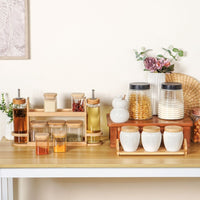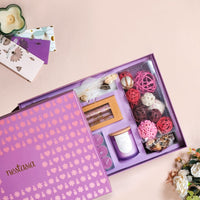“Where there is devotion, every offering becomes divine.”
– Swami Vivekananda
Janmashtami is one of those festivals that’s all heart. From midnight celebrations and bhajans to carefully laid-out thalis and bhog platters, it’s all about devotion with a side of laddoo, of course.
At Nestasia, we believe festive food isn’t just about what’s cooked, it’s about how it’s shared, styled, and served. That’s why we’ve put together this recipe guide filled with easy Janmashtami recipes you can actually make at home, whether you’re prepping Krishna bhog, putting together a simple prasad, or looking for tasty fasting recipes that still feel indulgent.
You’ll find classics like makhana kheer and coconut laddoo, comforting satvik food recipes for your vrat, and even a few modern takes (hello, shrikhand cheesecake cups). Every recipe is meant to help you celebrate with intention, tradition, and a whole lot of flavour. And because the joy is in the details, we’re also suggesting how to serve each dish beautifully.
This year, let your Janmashtami kitchen feel like an offering in itself with recipes that honour the spirit and serve the joy.
Recipes for Krishna Bhog And Prasad
When it comes to Janmashtami, cooking for Krishna is about more than taste; it’s about love, tradition, and the joy of offering. These simple yet soulful prasad recipes are perfect for your bhog thali, with ingredients you probably already have in your kitchen.
Makhan Mishri – Freshly Churned, Just Like Kanha Likes It
There’s something extra special about offering fresh homemade makhan to Krishna on Janmashtami. It’s simple, sacred and symbolic, exactly what a bhog recipe should be.
Ingredients:
1 cup fresh cream (malai), collected over a few days
Cold water or ice cubes (for churning)
2 tbsp mishri (rock sugar)
Chopped pista or almonds (optional)
Tulsi leaves (optional, for garnish)
Steps:
Collect malai (fresh cream) over 2–3 days and store it in the fridge.
Once you have about 1 cup, transfer it to a large bowl or blender.
Add a few tablespoons of cold water or a couple of ice cubes.
Blend or churn until the makhan (butter) separates from the liquid (buttermilk). This should take 3-5 minutes.
Scoop out the fresh makhan and gently press to remove excess liquid.
Place the makhan in a small serving bowl, top with mishri, and garnish with tulsi leaves and chopped nuts (optional).
Serve chilled as a pure and simple prasad offering.
Coconut Laddoo – The 10-Minute Wonder
Quick to make and loved by all, these soft and chewy laddoos are perfect for your Janmashtami bhog.
Ingredients:
2 cups desiccated coconut
1 cup condensed milk
1 tsp ghee
½ tsp elaichi powder
Steps:
Lightly roast the coconut in ghee for 1–2 minutes.
Add condensed milk and stir until the mixture thickens.
Turn off the heat and let it cool slightly.
Shape them into small laddoos and roll them in coconut.
Serve fresh on a platter or store in a jar in the fridge.
Makhana Kheer – Comfort in a Bowl
Rich, creamy, and vrat-friendly, this makhana kheer is both nourishing and festive.
Ingredients:
2 cups makhana (fox nuts)
1 litre full-fat milk
3 tbsp sugar
½ tsp elaichi powder
Chopped nuts (cashew, almond, pista)
1 tsp ghee
Steps:
Roast makhana in ghee until crisp, then crush slightly.
Boil milk and add the crushed makhana.
Let it simmer for 15–20 minutes, stirring often.
Add sugar, elaichi, and chopped nuts.
Serve warm or chilled as prasad.
Dhaniya Panjiri – The Mathura Classic
Made with coriander powder and ghee, dhaniya panjiri is a must-have on Janmashtami in many North Indian homes.
Ingredients:
1 cup dhaniya powder (coriander powder)
½ cup ghee
½ cup powdered sugar
2 tbsp grated coconut (optional)
Chopped nuts – almonds, cashews, raisins
Steps:
Heat ghee in a stainless steel pan, add dhaniya powder, and roast until aromatic.
Let it cool slightly before mixing in sugar, coconut, and dry fruits.
Serve as part of your bhog thali or enjoy as a quick energy bite during the day.
Fasting Food And Satvik Recipes for Janmashtami
These satvik food recipes are made without onion or garlic, making them perfect for those observing a vrat or looking for light yet nourishing fasting recipes.
Sabudana Khichdi – The Vrat Staple
A go-to fasting recipe that’s filling, easy to digest, and a classic on any vrat day.
Ingredients:
1 cup sabudana (soaked for 4–5 hours)
1 boiled potato, chopped
1 tsp cumin seeds
1–2 chopped green chillies
2 tbsp peanuts (roasted & crushed)
Sendha namak (rock salt), to taste
Ghee, for cooking
Coriander leaves, for garnish
Steps:
Heat ghee in a cooking pan, add cumin seeds, green chilli, and potatoes. Sauté for 2–3 minutes.
Add soaked sabudana, peanuts, and sendha namak.
Cook on low flame until the sabudana turns translucent.
Garnish with coriander and serve warm.
Fruit Chaat – Colourful & Cool
Hydrating and quick to prep, this fruit chaat is a great way to keep things light during Janmashtami fasting.
Ingredients:
A mix of fruits – banana, apple, papaya, grapes, pomegranate
Rock salt
A pinch of black pepper
Squeeze of lemon juice
Chopped mint (optional)
Steps:
Chop all fruits into bite-sized pieces.
Sprinkle with rock salt, pepper, and lemon juice.
Toss lightly. Add chopped mint if you like.
Serve chilled in a bowl or platter.
Vrat-Friendly Aloo Tikkis – Crispy, No Onion No Garlic
These satvik potato tikkis are perfect when you want comfort food that still fits the vrat rules.
Ingredients:
3 boiled potatoes
2 tbsp arrowroot flour or kuttu flour
Sendha namak (rock salt), to taste
1 tsp jeera (cumin seeds)
Green chilli, chopped
Ghee or oil for shallow frying
Steps:
Mash potatoes and mix with flour, jeera, green chilli, and salt.
Shape into small tikkis.
Shallow fry in ghee until golden and crisp.
Serve with homemade vrat-friendly chutney or curd.
Roasted Makhana – Quick Energy Snack
Crunchy and protein-packed, this simple fasting snack pairs well with any vrat thali.
Ingredients:
2 cups makhana
1 tsp ghee
Rock salt
Black pepper or red chilli powder (optional)
Steps:
Heat ghee in a pan, add makhana.
Roast on low heat for 5–7 minutes until crispy.
Sprinkle salt and spices.
Store in an airtight container or serve warm.
Modern Janmashtami Recipes with Traditional Flavours
These updated takes on traditional sweets give your Janmashtami recipes a fun, festive twist while still honouring the flavours of bhog and prasad.
Shrikhand Cheesecake Cups – Devotion Meets Dessert
This fusion dessert blends traditional prasad flavours with a creamy modern twist, perfect for a stylish Janmashtami meal.
Ingredients:
1 cup hung curd (Greek-style thick yoghurt)
2 tbsp powdered sugar
A pinch of saffron (kesar), soaked in 1 tbsp warm milk
¼ tsp elaichi powder (cardamom powder)
½ cup crushed digestive biscuits (or granola)
1 tbsp chopped pistachios (pista)
Steps:
Whisk together hung curd, sugar, saffron milk, and elaichi into a smooth shrikhand.
Add a layer of biscuit crumbs to small dessert plates.
Spoon shrikhand over the base.
Top with pistachios. Chill and serve.
Dry Fruit Energy Balls – No Bake, All Power
Quick, healthy, and vrat-friendly, these sweet bites make a great fasting snack or post-puja treat.
Ingredients:
1 cup soft dry fruits – dates (khajoor), figs (anjeer), raisins (kishmish)
¼ cup chopped nuts – almonds (badaam), cashew (kaju), walnuts (akhrot)
1 tbsp ghee (clarified butter)
Poppy seeds (khus khus) or desiccated coconut (optional)
Steps:
Blend dry fruits into a sticky paste.
Mix in chopped nuts and ghee.
Shape into bite-sized balls.
Roll in coconut or poppy seeds.
Saffron Milk Popsicles – Cool, Creamy, Festive
Think of it as frozen kheer- lightly spiced, chilled, and perfect for your Janmashtami recipes list.
Ingredients:
1 cup full-fat milk
2 tbsp condensed milk (milkmaid or mithai mate)
A pinch of saffron (kesar)
¼ tsp elaichi powder (cardamom powder)
1 tbsp chopped nuts (cashew, almond, pista)
Steps:
Heat milk with saffron and elaichi. Add condensed milk and stir.
Let it cool slightly. Add chopped nuts.
Pour into popsicle moulds and freeze overnight.
Run mould under warm water to release and serve chilled.
Rose Malai Toasts – The Sweetest Little Fusion
Inspired by classic bhog flavours, this toast is creamy, floral, and ideal for a modern Janmashtami prasad.
Ingredients:
2 slices of white bread
½ cup milk
1 tbsp condensed milk
½ tsp rose water (gulab jal)
Ghee (clarified butter), for toasting
Chopped pistachios (pista), rose petals for garnish
Steps:
Toast bread slices in ghee until crisp.
Simmer milk with condensed milk and rose water.
Pour warm malai mixture over toasted bread.
Garnish with pistachios and rose petals. Serve warm. 
Best Way To Serve Janmashtami Recipes Beautifully
Great recipes deserve to be served in a way that enhances their flavour and feeling. After all, Janmashtami food isn’t just made to be eaten; it’s made to be offered, shared, and celebrated. The right serveware can turn simple dishes into something sacred, and festive snacks into something unforgettable. Whether you’re laying out prasad, plating a full vrat thali, or just setting up a modern dessert, here’s how to present it beautifully:
Kansa Dinner Sets: Elegant and traditional, a Kansa dinner set is ideal for serving prasad like makhan mishri or dhaniya panjiri. The metal’s warm glow instantly elevates any bhog thali, making it feel closer to a temple-style offering.
Marble Platters: Polished and timeless, a marble serving platter adds a luxe touch to modern sweets like shrikhand cheesecake cups or rose malai toasts. The clean surface highlights dessert colours beautifully.
Clay Pots & Terracotta Tumblers: Serve makhana kheer or roasted makhana in clay pots or pair with a terracotta tumbler for drinks like saffron milk. Their raw, earthy finish brings an authentic, devotional charm to your Janmashtami setup.
Terracotta Dishes: For dishes like sabudana khichdi or fruit chaat, terracotta dishes add a rustic, grounded feel. They pair well with satvik meals and blend tradition with minimal effort.
Wooden Platters: Display vrat snacks like aloo tikkis or dry fruit energy balls on a wooden platter or a unique wooden elephant riser. It’s an easy way to layer bowls, play with height, and create a festive, abundant spread.

Janmashtami cooking isn’t about perfect recipes; it’s about meaningful ones. Whether you’re preparing a quiet bhog at home or gathering with family over a thali of satvik favourites, what matters most is the thought behind every dish. These meals carry tradition, care, and a little bit of joy in every bite.
With Nestasia’s help, your celebrations don’t just taste special, they look it too. So light the diya, serve with intention, and let your table reflect the love you’ve poured in.
Because Krishna doesn’t ask for a feast, He always accepts what’s made with love.
























